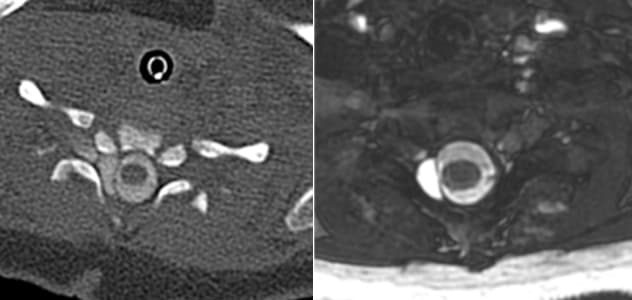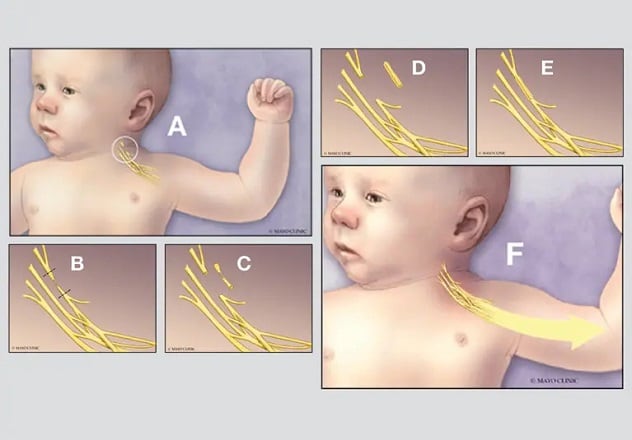May 26, 2023
Optimal treatment of brachial plexus injuries requires surgical knowledge in components from the brain to the hand. Mayo Clinic's brachial plexus team merges the expertise of multiple specialists to care for infants, children and adults with these complex injuries.
"Our interdisciplinary approach goes beyond gathering input from multiple specialists. We blend that expertise to provide integrated care," says Robert J. Spinner, M.D., a peripheral nerve surgeon and chair of Neurologic Surgery at Mayo Clinic in Rochester, Minnesota.
"We can get neurosurgeons, hand surgeons and pediatric orthopedic surgeons all in the same room to evaluate these patients. It's part of the culture here."
Individuals referred to Mayo Clinic's brachial plexus clinic with injuries deemed urgent are often evaluated over just two days. When indicated, surgery can be performed on Day 3. The interdisciplinary team has experience with all treatment options, including neurolysis, nerve graft, nerve transfer and muscle transfer.
"No two patients are alike. No brachial plexus injury is exactly like another," Dr. Pulos says. "We bring to the table a level of expertise from decades of performing these surgeries."
Rapid patient pathways
Brachial plexus lesions have been treated at Mayo Clinic for approximately a century. The interdisciplinary brachial plexus clinic, launched in 2001, sees about 180 patients a year — making it one of the highest-volume brachial plexus practices in the United States. The injuries range from mild to severe.
"Adult injuries are usually due to trauma — such as motorcycle or snowmobile accidents — but also road biking and skiing," Dr. Pulos says. "We're also seeing these high-energy injuries more in teenagers and children who ride dirt bikes or all-terrain vehicles."
For optimal results, surgery to repair brachial plexus nerves should occur within six months of injury. Milder injuries might resolve without surgery but require evaluation and monitoring.
As described in the December 2022 issue of the Journal of Hand Surgery (European Volume), Mayo Clinic's care process starts before patients arrive on campus. Referrals are triaged based on pre-screening of medical records. For individuals with injuries deemed urgent, testing is ordered and surgeries are scheduled. The procedures can be canceled if subsequent clinical evaluations determine that surgery isn't indicated.
"We order efficient testing and consultations because many of our patients travel from across the United States and internationally," says Michelle F. Loosbrock, R.N., the brachial plexus clinic's nurse coordinator. "Our goal is to make a stressful time for patients as easy and smooth as possible."
Once on campus, patients have an initial evaluation with a neurologist specializing in peripheral nerves. Electromyography (EMG), CT myelography (CTM), vascular imaging and other radiographic studies as needed also are performed on that first day.
Imágenes integrales

Imágenes integrales
Mielografía por tomografía computarizada axial (izquierda) y resonancia magnética con secuencias rápidas mediante adquisición en el estado estacionario (derecha). Ambas imágenes muestran la avulsión de las raíces ventrales y dorsales de C7, C8 y T1. Hay un pseudomeningocele en C7-T1.
CTM is often considered the gold standard imaging technique for the diagnosis of nerve root avulsion injuries in traumatic brachial plexopathies. However, MRI is sometimes performed in conjunction with CTM or separately, depending on individual patients' needs.
"While CTM has better spatial resolution than MRI, it is invasive and can be uncomfortable," says Laurence J. Eckel, M.D., a neuroradiologist at Mayo Clinic's campus in Minnesota. "MRI has the advantage of lacking radiation and has no intrathecal contrast administration."
On the second day, the brachial plexus team of surgeons together examines each patient and formulates opinions. Additional consultations might be scheduled with specialists in pain management, vascular or hand surgery, physical medicine and rehabilitation, and physical or occupational therapy.
"The most challenging part of these cases is the clinical decision-making," Dr. Pulos says. "We hold open discussions between patients, family members and multiple brachial plexus surgeons to determine a unified plan."
Two or three brachial plexus surgeons perform procedures when needed on Day 3. A neurologist in the operating room interprets intraoperative nerve monitoring. Follow-up evaluations and testing also are planned.
"We can take care of everything in a one-stop shop," Dr. Spinner says.
Pediatric care
Brachial plexus injuries in newborns present unique challenges. "As opposed to a high-energy trauma, injuries that happen during birth are slow, prolonged tractions on the nerve," Dr. Pulos says. "The brachial plexus responds to that injury in different ways in different patients."
Baseline evaluations should be performed in the first months of life. Mayo Clinic offers virtual consultations.
"It's never too soon for us to see newborns with brachial plexus injuries. We have to decide in a limited time period whether a child will improve spontaneously or would see greater improvement from surgery."
Cirugía neonatal por lesión del plexo braquial

Cirugía neonatal por lesión del plexo braquial
La ilustración muestra lo que ocurre durante la cirugía neonatal por lesión del plexo braquial. A. El plexo braquial está ubicado en el cuello por encima de la clavícula. B. El segmento dañado y el nivel de lesión se identifican en la cirugía. C y D. El segmento dañado se retira y luego se lo reconstruye tomando segmentos de injerto de nervio de la pierna y agrupándolos en cable para que coincidan con el tamaño del nervio dañado. E y F. El injerto de nervio en cable se cose en su lugar mediante microcirugía, lo que permite que el nervio se regenere para restaurar la función de los músculos paralizados.
To avoid muscle degeneration, nerve surgery should be performed between the ages of 3 and 9 months. "The most common time is around 6 months," Dr. Pulos says. "We often intervene earlier with more-severe injuries, if we recognize that there's minimal chance of spontaneous recovery."
Pediatric anesthesiologists care for young patients undergoing diagnostic studies and surgery. Treatment strives to ensure that children can bend their elbows, grasp objects and bring their hands to their mouths.
"Those priorities differ from our approach with adults," Dr. Spinner says. "It's extremely challenging in adults to obtain function below the elbow. Nerve regeneration is too slow, and the distance is too long. In babies the regeneration time is the same, but the distance is short."
Imbalances in growth from nerve injury around the shoulder can lead to secondary sequelae in children: typically, internal rotation contracture and the inability to externally rotate and elevate the shoulder. Mayo Clinic recommends secondary surgery to address those issues.
"Some issues, such as supination contracture of the forearm, don't develop and aren't treated surgically until about age 5," says William J. Shaughnessy, M.D., an orthopedic surgeon in the Mayo Clinic Children's Center at Mayo Clinic's campus in Minnesota. "Other issues, such as posterior subluxation of the shoulder, are treated whenever they occur — generally between the ages of 2 and 18."
Secondary surgery usually results in increased range of motion. Shoulder function can improve, and the brachial plexus abnormality can be less noticeable.
"In many cases, classmates and teachers aren't aware of a child's brachial plexus palsy."
As a major neurological and orthopedic center, Mayo Clinic can follow brachial plexus patients from childhood into adulthood. "We have the best of both worlds," Dr. Pulos says. "Expert pediatric orthopedic surgeons care for these patients when they're young, and then they transition to an adult specialist."
The interdisciplinary brachial plexus clinic epitomizes the Mayo Clinic Model of Care, which fosters collaboration rather than competition.
"When individuals with so much expertise and experience work together, they can do surgeries that simply could not be done by a single individual," Dr. Shaughnessy says. "The combined effort of all these individuals under one roof — and in one room — is incredible."
For more information
Shin AY, et al. A multidisciplinary approach to the management of brachial plexus injuries: Experience from the Mayo Clinic Over 100 Years. Journal of Hand Surgery (European Volume). 2022;47:1103.
Refer a patient to Mayo Clinic.